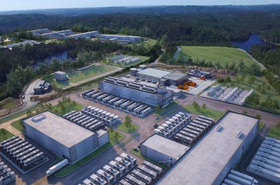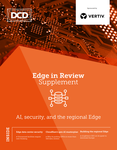Whether, and how best, to use Artificial Intelligence (AI) has become one of the most polarising debates in recent months. Where the rise of AI applications has seen calls for stricter regulation from some, others see AI as the clear means to boost productivity and innovation into the future. Regardless of which side you sit on, AI’s implementation is set to rise, driving a growing need for data processing infrastructure along with it – but as we build more capacity, how can we ensure that these facilities continue to meet important sustainability and efficiency standards?
This infrastructure demand is continuing to propel the data center market, which, with a forecasted compound annual growth rate (CAGR) of 5.05 percent over the next 5 years, outperforming many sectors in the UK economy. London remains a top performer, with a 5-year CAGR of 10.32 percent and the recent launch of a number of 5G projects set to further boost growth in the region.
However, while the growth figures look promising, the data center sector is facing increased pressure for more transparency on how they will expand on their climate mitigation strategies. In response, the sector is ramping up its focus on sustainability, with Gartner predicting that 75 percent of data center organizations will have a sustainability-focused project up and running by 2027. In recent months, data center projects have seen delays in planning applications on the grounds of sustainability credentials. Factoring in enhanced environmental and sustainability measures early could therefore become a key way to limit delays and the associated impact on the bottom line for new projects.
So, how can data center providers maintain growth while positively contributing to the future of the planet?
AI could provide a solution to this problem. By collecting and analyzing large datasets and visualizing future workloads, AI can help to measure and enhance the use of energy, resources, and operations.
Let’s first look at how AI can be deployed in monitoring energy use. Data center operators such as Huawei, are already using AI to monitor energy use in facilities in order to identify ways to reduce consumption without holding back on processing. For example, Huawei’s iManager, which, according to reports, uses AI to manage data center power allocation, is estimated to improve the resource utilization rate of its facilities by 20 percent.
When it comes to energy use, cooling systems can represent up to 40 percent of a data center’s energy consumption, making this a key area of research for enhancing energy performance. Reports from US-based Internet and data center company, Equinix, show how this can be done at scale. Equinix has recently announced a partnership with a German energy intelligence start-up, which will see the launch of a Frankfurt facility designed for the testing of AI in data center operations. Where Google’s Deepmind AI, back in 2016, developed temperature-based algorithms which it said would cut energy use by 15 percent, one of Equinix’s Frankfurt projects is reported to have the potential to go further. It is aiming to reduce the annual energy input of cooling systems by 48 percent, by utilizing data from external weather conditions and operational loads to bring in optimized cooling strategies.
Energy demands can be further reduced if data center functions are made more efficient. Again, AI can unlock opportunities for operational efficiency, by modeling performance.
Where digital twins are being used to provide 3D models of data center design and operations, AI can enhance the capabilities of these systems by simulating functions to correct and prevent the running of inefficient processes. For instance, Cadence’s 6Sigma digital twin uses a predictive simulation approach, combining AI with software analytics and machine learning to not only monitor and assess performance but also to predict cost profiles and capacity before data centers are built.
To reap the benefits of improved data center operations over time, the machines themselves need to be well maintained. This is where AI-powered predictive maintenance can be used to extend the lifespan of equipment. In addition to its iManager system, Huawei has developed iPower, an intelligent power supply and distribution technology that can predict battery life span. This identifies maintenance needs before any failures occur. It also detects and isolates faults to improve power infrastructure and reduce the risk of fire in facilities. This not only reduces downtime but ensures that components last longer.
Finally, for data centers to truly form part of the UK’s green transition, renewable energy sources need to be integrated into operations. Data centers that run on renewable energy, such as Newcastle’s Stellium projects, are well positioned to maximize on AI’s energy management capabilities. As seen with commercial buildings, AI can be used to monitor operations and find the optimal time to switch between traditional to renewable energy sources in line with fluctuations in supply and demand.
Just as it represents a quantum leap for computing, AI has the potential to revolutionize the sustainability of data centers, ensuring a positive environmental, societal, and governmental impact for the sector and its local communities.








